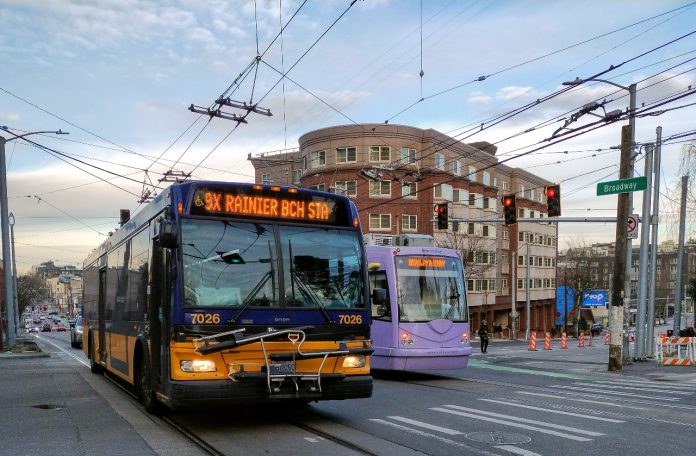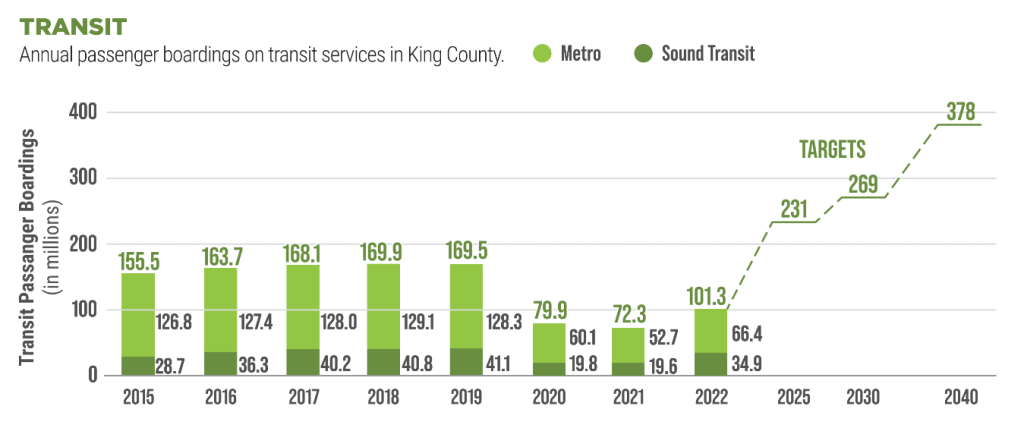
A newly released report produced by King County looking at progress implementing the goals of its 2020 Strategic Climate Action Plan (SCAP) points toward a need to rapidly start making progress in the area of transportation or risk missing climate targets laid out in the plan. For a County Council deciding whether now is the time to put a substantive property tax levy on the ballot to fund climate initiatives, the report provides some badly needed perspective on what exactly the county needs to do to catch up.
The SCAP calls for a 25% reduction in countywide emissions by 2025, a 50% reduction by 2030, and a 80% reduction by 2050, all compared to a 2007 baseline. Around one-third of the expected gains in emission reductions by 2030 are expected to come from improved transportation outcomes: shifting trips out of single-occupancy vehicles and into other modes.

In an introduction to the report, County Executive Dow Constantine touts progress that the county has made toward its goals over the past few years, following its adoption by the King County Council in 2021.
“The 2023 Biennial Report provides an update on all commitments made in the 2020 SCAP and paints a familiar picture: the County is effectively advancing climate action to reduce emissions, leading on climate equity, and preparing for the impacts of climate change but we need to do more to invest in the County and community we want to leave to future generations,” Constantine writes.
But two significant progress indicators around transportation emissions are highlighted in red in the report — items that need “serious course correction.” Transit usage remains well below the 2025 goal of 231 million annual boardings as laid out in the plan, and contrary to the SCAP’s goal of decreasing the total number of vehicle miles traveled countywide in passenger vehicles and light duty trucks, total car use in the county continues to rise. These two metrics, undeniably linked together, point toward a need to make rapid investments in transit to meet both near- and long-term climate goals.
Reduce car trips by 20% by 2030
According to the report, in 2022 King County saw a net 2% increase year-over-year in the amount of total travel in passenger vehicles and light duty trucks, to 15.6 billion miles — over 6,700 miles for every single King County resident. The goal laid out in the plan is a 20% reduction from 2017 levels by 2030 and so far that number has increased over 2017 levels by 8%. Things are flat-out heading in the wrong direction.

“Smart land use strategies, implementation of equitable vehicle usage pricing policies, and major investments in regional transit service” are doctor’s orders for King County, according to the progress report, if the goals contained in the SCAP are to get back on track.
As far as land use strategies go, the county is only able to directly dictate growth patterns in unincorporated areas like Skyway, Vashon Island, and White Center. But County government also plays a big role in halting potential shifts in the Urban Growth Boundary (UGB), preventing exurban sprawl that drives increased car travel. Last year, it was largely King County elected officials from urban areas who voted to reject a proposal that would have allowed more sprawl near I-90 around Snoqualmie and North Bend in exchange for preservation of open space.

The issue of implementing vehicle pricing is largely dependent on the Washington State Legislature, even as Central Puget Sound’s entire transportation plan depends on creating a robust and dynamic “road usage charge” (RUC). The Puget Sound Regional Council’s Regional Transportation Plan, adopted in 2022, assumes that by 2030 Washington will implement a per-mile driver fee of 10 cents per mile during peak hours and 5 cents off-peak. Yet road usage charges that have been proposed at the state legislature and discussed by the state transportation commission have all only consisted of a flat 2.7 cents-per-mile fee that would simply replace gas tax revenue and not influence behavior.
Unless there’s a seismic shift in statewide politics around the RUC — exceedingly unlikely given the tenor of conversations around the gas tax — the county won’t be able to count on a robust vehicle pricing plan to create mode shift.
The lever that the county has the most control over is public transit, an area where things have mostly been treading water.
Significant additional transit investments needed
In 2022, King County Metro and Sound Transit together saw over 101 million transit boardings across the county, just under 60% of the total from 2019. Ultimately, King County’s climate goals depend not just on returning to 2019 ridership levels but growing it significantly, a task that was originally supposed to be accomplished with the help of the County’s Metro Connects plan.
“Despite recent recoveries these totals are still considerably lower than needed to meet ridership targets set out in the SCAP,” the progress report notes. “Metro is taking actions to bring riders back, such as working to address safety concerns and improve reliability through service changes. More work will be needed to recover and grow ridership towards the SCAP goals.”
By 2025, the SCAP calls for total boardings countywide to increase to 231 million annually, a 36% increase compared to 2019. But the report confirms that Metro is focused on being able to deliver on the service levels it has committed to now before current county government will feel comfortable taking the next step and putting a regional transit funding measure on the ballot. “Metro, Executive leadership, and partners recognize that implementing Metro Connects will require additional funding, Metro also must be in a position to effectively deliver system growth whenever additional funding is secured, which is why Metro’s priority is improving reliability, perception of safety, and maintaining and restoring existing service,” the report states.

That transit ballot measure will likely be completely distinct from the climate ballot measure under consideration by Executive Constantine right now, after it was requested last year by transportation, economy, and the environment committee chair Rod Dembowski. Yet this progress report makes it clear just how substantially King County’s shortfalls on its climate goals are transportation-related. This raises big questions about going to the voters without being ready to meaningfully address the county’s largest share of emissions.
When it comes to the county’s role in promoting walking and biking, the SCAP’s goals are primary focused on regional trails, and include a very modest target of completing 10 miles of multi-use trails in a decade. The 6.7 miles completed so far includes the stretch of the East Lake Sammamish Trail that opened last year after a 20-year battle with property owners. The 10-mile goal is ultimately completely disconnected from the work of local jurisdictions who are in charge of connecting to the regional trail network, and illustrates the compartmentalization that will absolutely prove a barrier when it comes to making progress across levels of government to achieve needed work on climate.

With emissions goals so off track when it comes to transportation, it will take intense focus from County government to get regional governments, state actors, and regional players all pushing in the right direction to ensure that investments are fully maximized. If that doesn’t happen, the most likely outcome is that everyone will continue to tread water and ambitious plans will continue to collect dust.
Ryan Packer has been writing for The Urbanist since 2015, and currently reports full-time as Contributing Editor. Their beats are transportation, land use, public space, traffic safety, and obscure community meetings. Packer has also reported for other regional outlets including BikePortland, Seattle Met, and PubliCola. They live in the Capitol Hill neighborhood of Seattle.

